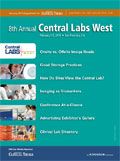Good Storage Practices
The importance of managing the storage and transportation of clinical trial samples.
The pharmaceutical industry's recent shift of focus to molecular therapies, genomics, and biomarker discoveries in medical research has increased the need for well-preserved biological samples. This has created substantial value for samples derived from clinical research.

PHOTO: GETTY IMAGES
Today, high-quality tissue, blood, and serum samples derived from clinical trial patients can be used to advance a wide range of medical endeavors. As such, preserving samples to the highest standards has become a critical component in maximizing the value of present day and future clinical research.
Critical responsibility
By utilizing today's high-throughput analytical and molecular technology, quality biospecimens are used to detect biomarkers, identify new applications for existing targeted treatments, accelerate drug development, and create biomarker-targeted diagnostics and therapeutics. Temperature control and monitoring during the storage and transportation ensures the efficacy of samples for future analyses.
To ensure the integrity and long-term viability of clinical samples, pharma and biotech companies will need to develop strategies for the specialized storage and transportation of these samples. Without careful consideration for compliant storage, shipping, data management, and audit trails, researchers risk damaging or losing clinical research samples. This, in turn, has serious time and financial implications on the clinical trial process.
Consider the consequences if clinical trial samples were to thaw out before reaching the testing lab, rendering the samples useless. This compromise could cost the sponsor hundreds of thousands of dollars to repeat the trial. Moreover, if samples are delayed at customs and don't reach their destinations on time, it could have a ripple effect on the development process by increasing the time it takes to bring a new product to market. This could consequently cost the sponsor millions of dollars, as a day lost in development is a day lost on the market.
Furthermore, regulatory agencies increasingly require more detailed information for the approval of new drugs. A complete audit trail detailing the sample's history from collection to destruction protects sponsors from clinical trial setbacks that could postpone product launch.
A lack of planning can prove costly, as these materials represent today's multimillion dollar research investments and tomorrow's multibillion dollar revenue. By developing a strategic sample management plan that takes into account best practices for temperature-controlled storage and logistics, regulatory guidelines, and audit trails, organizations can protect financial investments while streamlining the research processes.
Good storage practices
Similar to other GXP environments, good storage practices require the discipline and attention to critical details, such as regulatory and industry compliance, data management, and quality and risk management. Good storage practices should be described in Standard Operating Procedures (SOPs) to ensure that processes are widely recognized and constantly met by personnel. These SOPs should be incorporated into routine training programs, and should be regularly updated to guarantee compliance to an expanding array of regulatory requirements from a number of entities.
The U.S. FDA, the Centers for Disease Control, and professional organizations such as the American Association of Tissue Banks, the National Cancer Institute, the American Association of Blood Banks, the International Red Cross, and the International Society for Biological Repositories provide guidelines for biorepositories and human sample banks. Without SOPs that take into consideration these guidelines, staff turnover may jeopardize sample integrity through loss of knowledge that occurs when an employee leaves an organization.
Additionally, other factors to incorporate into good storage practices include:
- Secure facilities and redundant measures to ensure specimens are kept in compliant conditions at all times when in storage
- Expert staff that has been trained specifically in sample storage and transportation to ensure all regulatory and custom issues are properly handled
- Storage technologies capable of monitoring the temperature of samples around the clock in order to provide a complete audit trail
- Business continuity plans and redundant systems to protect sample integrity during emergencies.
The biomaterial cold chain
As clinical research continues its migration toward globalization, expanding into regions such as South America, Eastern Europe, and East Asia, the process of transporting human clinical trial samples has become increasingly complex. Regulatory requirements, temperature-control, and worldwide custom concerns have made transporting clinical trial samples a science in itself. As a result, companies should develop a strategy for cold chain management to maintain visibility and control over clinical samples to ensure they are not compromised by temperature deviations while in transit.
A comprehensive cold chain management plan defines how temperature-sensitive products and biomaterials such as clinical trial samples, active pharmaceutical ingredients, and microbiological and viral samples are packaged, transported, and stored throughout the research and development process. Maintaining the integrity of the cold chain requires logistics and management expertise to ensure that temperature-sensitive samples are constantly monitored and properly packaged so they do not degrade during packing, shipping, processing, and storage.
From a regulatory perspective, lack of compliance can delay shipments at inspection points or subject drug developers to fines ranging from a few hundred to thousands of dollars. To ensure compliance, mitigate financial risk, and reduce development setbacks, sponsors must take a comprehensive approach to cold chain management in which the process is an integrated component of the organization's overall best practices.
Information management and audit trails
In order for analysis to be meaningful and accurate, an effective system must be capable of reporting processes through all stages of a sample's shipping, handling, and storage lifecycle. Therefore, inherent in good storage practice is maintaining the associated documentation that provides verification that samples have been stored in appropriate conditions from collection to final retrieval.
Audit trails are required by various regulatory agencies to help establish that samples have not been compromised while in transit or in storage. Most notably, the FDA and international Current Good Laboratory Practices, Current Good Manufacturing Practices, and Current Good Clinical Practice have regulations that affect various aspects of clinical development including storage, transportation, and electronic documentation. Title 21 CFR Part 11, for example, considers electronic records to be trustworthy, reliable, and generally equivalent to paper records and handwritten signatures. This rule applies to records in electronic form that are created, modified, maintained, archived, retrieved or transmitted in FDA-regulated industries.
For a comprehensive audit trail, records must form a complete history of the sample's lifecycle, and include:
- The type of sample, such as tissue, blood, plasma or other
- Who and where the samples were collected from
- Date the specimen was obtained
- Storage and shipping conditions of the sample at all times
- The final destination of the sample.
In addition to audit trails, information management plays a critical role in drug development. Researchers are also analyzing a vast amount of clinical information about patients' health and disease from patient records and clinical trials. This data helps researchers identify patterns and disease sub-types, therefore leading to effective strategies for diagnosing and treating disease in new and efficient ways. Because of this, good storage practices require that samples and their associated data be well-kept and easily accessible if needed. This is truly important, as in many cases the genomic information that accompanies the physical sample is as important as the sample itself.
To maintain accessibility of archived samples and their data, companies should consider implementing robust, multifaceted laboratory information management systems (LIMS) to help facilitate sample management and data collection. Today's sophisticated LIMS software handles receiving, processing, and storing information generated by lab processes. This ensures that each sample is protected and stored in a compliant manner, while streamlining the process of sample management, making information readily available to certified users of the system.
Conclusion
Due to the commercial and scientific significance of these samples, materials should not be left to ad hoc processes that may jeopardize the integrity of such valuable property. This is especially true today as the value of such materials is rapidly increasing through discoveries that can be made from ongoing testing. As such, now is the time for organizations to establish a comprehensive management strategy that incorporates and dictates how samples are handled, stored, transported, and documented throughout their entire lifecycle. This ensures the integrity of clinical trial samples, which help accelerate product development and lead to new therapeutics.
Despite this, companies often overlook the critical step of developing strategies for specialized, long-term storage of biological samples. This could have serious financial ramifications, as biospecimen management, storage, and retrieval have become increasingly important aspects in improving the efficiency of drug development. Due to these factors, it's only a matter of time before researchers and regulatory bodies alike adopt good storage practices universally. The question is, will you be ready?
Andrew J. Mills, is Global Director of Marketing and Commercial Operations at BioStorage Technologies, 2655 Fortune Circle West, Suites A-B, Indianapolis, IN 46241, email: andrew.mills@biostorage.com.
References
1. S. Cubbler, "The Logistics of a Successful Product Launch," Pharmaceutical Commerce, September 30, 2009, http://www.pharmaceuticalcommerce.com/frontEnd/1284Exel_launch_logistics_pharmaceutical_Cubbler.html.
2. Key Medicines and Their Performance. Pfizer Annual Review, http://www.pfizer.com/investors/financial_reports/annual_reports/key_medicines.jsp (2008).
3. National Cancer Institute and Biorepositories—Office of Biorepositories and Biospecimen Research, NCI Cancer Bulletin 6 (9). (May 5, 2009), http://biospecimens.cancer.gov.
Improving Relationships and Diversifying the Site Selection Process
April 17th 2025In this episode of the Applied Clinical Trials Podcast, Liz Beatty, co-founder and chief strategy officer, Inato, discusses a number of topics around site engagement including community-based sites, the role of technology in improving site/sponsor relationships, how increased operational costs are impacting the industry, and more.
Behind the Buzz: Why Clinical Research Leaders Flock to SCOPE Summit
February 7th 2025In this episode, we meet with Micah Lieberman, Executive Conference Director for SCOPE Summit (Summit for Clinical Ops Executives) at Cambridge Innovation Institute. We will dive deep into the critical role of collaboration within the clinical research ecosystem. How do we bring together diverse stakeholders—sponsors, CROs, clinical trial tech innovators, suppliers, patients, sites, advocacy organizations, investors, and non-profits—to share best practices in trial design, program planning, innovation, and clinical operations? We’ll explore why it’s vital for thought leaders to step beyond their own organizations and learn from others, exchanging ideas that drive advancements in clinical research. Additionally, we’ll discuss the pivotal role of scientific conferences like SCOPE Summit in fostering these essential connections and collaborations, helping shape the future of clinical trials. Join us as we uncover how collective wisdom and cross-industry partnerships are transforming the landscape of clinical research.
